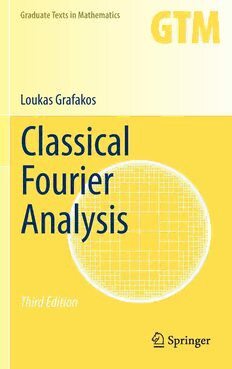
Classical Fourier Analysis, Third Edition [3rd Ed] (Instructor Solution Manual, Solutions) PDF
Preview Classical Fourier Analysis, Third Edition [3rd Ed] (Instructor Solution Manual, Solutions)
Loukas Grafakos Classical Fourier Analysis, Third Edition Solutions of all the exercises – Monograph – January22,2014 Springer v Iwouldliketoexpressmydeepgratitudetothefollowingpeoplewhohelpedinthepreparationofthesolutionsofthebooks ClassicalFourierAnalysis,3rdedition,GTM249andModernFourierAnalysis,3rdedition,GTM250. Mukta Bhandari, Jameson Cahill, Santosh Ghimire, Zheng Hao, Danqing He, Nguyen Hoang, Sapto Indratno, Richard Lynch,DiegoMaldonado,HanhVanNguyen,PeterNguyen,JessePeterson,SharadSilwal,BrianTuomanen,XiaojingZhang, Iremainsolelyresponsibleforanyerrorcontainedintheenclosedsolutions. Contents vii 1. Lp Spaces and Interpolation Section1.1.Lp andWeakLp Exercise1.1.1 Suppose f and f aremeasurablefunctionson(X,µ).Provethat n (a)d isrightcontinuouson[0,∞). f (b)If|f|≤liminf |f |µ-a.e.,thend ≤liminf d . n→∞ n f n→∞ fn (c)If|f |↑|f|,thend ↑d . (cid:2) n fn f Hint:Part(a):Lett beadecreasingsequenceofpositivenumbersthattendstozero.Showthatd (α +t )↑d (α )using n f 0 n f 0 a convergence theorem. Part (b): Let E ={x∈X : |f(x)|>α} and E ={x∈X : |f (x)|>α}. Use that µ(cid:0)(cid:84)∞ E (cid:1)≤ n n n=m n liminfµ(E )andE(cid:106)(cid:83)∞ (cid:84)∞ E µ-a.e.(cid:3) n m=1 n=m n n→∞ Solution. (a)Forallα >0letE ={x∈X : |f(x)|>α}.Fixα ≥0andlett beadecreasingsequenceofpositivenumbersthattends α 0 n to0.ObservethatE (cid:106)E foreveryn.Thereforeχ ↑χ asn→∞,sobytheLebesguemonotoneconvergence α0+tn α0+tn+1 Eα0+tn Eα0 theoremitfollowsthat µ(E )↑µ(E ) α0+tn α0 whichestablishesthedesiredconclusion. (b)FirstnotethatE⊆∪∞ ∩∞ E µ−a.e.,sowehave m=1 n=m n d (α)=µ(E)≤µ(∪∞ ∩∞ E )≤liminfµ(E )=liminfd (α). f m=1 n=m n n→∞ n n→∞ fn (c)LetE andE beasabove.TheclearlywehaveE ⊆E andlim E =E,sotheconclusionfollowsfromtheLebesgue n n n+1 n→∞ n monotoneconvergencetheoremasinpart(a). (cid:4) Exercise1.1.2 (Ho¨lder’sinequality)Let0<p,p1,...,pk≤∞,wherek≥2,andlet fj beinLpj =Lpj(X,µ).Assumethat 1 1 1 = +···+ . p p p 1 k (a)Showthattheproduct f ···f isinLpandthat 1 k (cid:13) (cid:13) (cid:13) (cid:13) (cid:13) (cid:13) (cid:13)f1···fk(cid:13)Lp ≤(cid:13)f1(cid:13)Lp1···(cid:13)fk(cid:13)Lpk. 1 2 Contents (b)Whenno pj isinfinite,showthatifequalityholdsinpart(a),thenitmustbethecasethatc1|f1|p1 =···=ck|fk|pk µ-a.e. forsomec ≥0. j (c) Let 0<q<1 and q(cid:48) = q−q1. For r<0 and g>0 almost everywhere, define (cid:107)g(cid:107)Lr =(cid:13)(cid:13)g−1(cid:13)(cid:13)−L|1r|. Show that if g is strictly positiveµ-a.e.andliesinLq(cid:48) and f ismeasurablesuchthat fgbelongstoL1,wehave (cid:13) (cid:13) (cid:13) (cid:13) (cid:13) (cid:13) (cid:13)fg(cid:13)L1 ≥(cid:13)f(cid:13)Lq(cid:13)g(cid:13)Lq(cid:48). Solution. (a)Wemayassumethatall pj<∞,sinceotherwise,onecanfactorfromthe(cid:107)f1···fk(cid:107)Lp theL∞ normofthe fj’swith pj=∞ andtheinequalityreducestotheremaining p ’swhicharenotinfinite. j Ifone(cid:107)fj(cid:107)Lp1 is0or∞,thentheconclusionisobvious.Let f j F = j (cid:107)fj(cid:107)Lp1 Theconvexityofet impliestheinequality 1 1 a a ap1 ···apk ≤ 1 +···+ k 1 k p p 1 k when1<p <∞and 1 +···+ 1 =1.Usingthisinequalityweobtain j p1 pk2 (|F|p1)p11 ···(|F|pk)p1k ≤ |f1|p1 +···+ |fk|pk . p1(cid:107)f1(cid:107)Lp1 pk(cid:107)fk(cid:107)Lpk Integratingandusing p11+···+p1k =1,weobtain(cid:107)f1···fk(cid:107)L1≤(cid:107)f1(cid:107)Lp1···(cid:107)fk(cid:107)Lpk.Forp(cid:54)=1reducetheinequalitytothecase p=1asfollows: 1 (cid:16) (cid:17)1 (cid:107)f1···fk(cid:107)Lp =(cid:107)|f1···fk|p(cid:107)Lp1 ≤ (cid:107)|f1|p(cid:107)Lpp1 ···(cid:107)|fk|p(cid:107)Lppk p =(cid:107)f1(cid:107)Lp1···(cid:107)fk(cid:107)Lpk usingthefactthat1/p +···+1/p =1/pisequivalentto(p /p)−1+···+(p /p)−1=1. 1 k 1 k (b)Wenotethatequalityintheinequality 1 1 a a ap1 ···apk ≤ 1 +···+ k 1 k p p 1 k holdsifandonlyifa =···=a .Indeed,thisinequalityisarestatementofthefactthatt(cid:55)→et isconvex.Andsinceet isstrictly 1 k convex,itfollowsthatequalityholdsintheprecedinginequalityifandonlyifallthea ’sareequaltoeachother.Usingthis j aj=|fj|pj/(cid:107)fj(cid:107)Lpj,weobtaintheclaimwithcj=(cid:107)fj(cid:107)−Lp1j. (c)Wehave (cid:107)f(cid:107)Lq =(cid:107)fgg−1(cid:107)Lq ≤(cid:107)fg(cid:107)L1(cid:107)g−1(cid:107)L|q(cid:48)| =(cid:107)fg(cid:107)L1(cid:107)g(cid:107)−Lq1(cid:48), since1= 1+ 1 implies 1 = 1+ 1 .Theconclusionfollows. (cid:4) q q(cid:48) q 1 |q(cid:48)| Exercise1.1.3 Let(X,µ)beameasurespace. (a)If f isinLp0(X,µ)forsome p0<∞,provethat (cid:13) (cid:13) (cid:13) (cid:13) lim(cid:13)f(cid:13) =(cid:13)f(cid:13) . p→∞ Lp L∞ (b)(Jensen’sinequality)Supposethatµ(X)=1.Showthat Contents 3 (cid:18)(cid:90) (cid:19) (cid:13) (cid:13) (cid:13)f(cid:13) ≥exp log|f(x)|dµ(x) Lp X forall0<p<∞. (c)Ifµ(X)=1and f isinsomeLp0(X,µ)forsome p0>0,then (cid:18)(cid:90) (cid:19) (cid:13) (cid:13) lim(cid:13)f(cid:13) =exp log|f(x)|dµ(x) p→0 Lp X withtheinterpretatione−∞=0. (cid:2)Hint:Part(a):If0<(cid:107)f(cid:107)L∞ <∞,usethat(cid:107)f(cid:107)Lp ≤(cid:107)f(cid:107)(Lp∞−p0)/p(cid:107)f(cid:107)Lp0p0/p toobtainlimsupp→∞(cid:107)f(cid:107)Lp ≤(cid:107)f(cid:107)L∞.Conversely,let Eγ ={x∈X : |f(x)|>γ(cid:107)f(cid:107)L∞} for γ in (0,1). Then µ(Eγ)>0, (cid:107)f(cid:107)Lp0(Eγ) >0, and (cid:107)f(cid:107)Lp ≥(cid:0)γ(cid:107)f(cid:107)L∞(cid:1)(p−p0)/p(cid:107)f(cid:107)Lp0p0/(pEγ), 1 hence liminfp→∞(cid:107)f(cid:107)Lp ≥γ(cid:107)f(cid:107)L∞. If (cid:107)f(cid:107)L∞ =∞, set Gn ={|f|>n} and use(cid:82)that (cid:107)f(cid:107)Lp ≥(cid:107)f(cid:107)L(cid:0)p((cid:82)Gn) ≥nµ(cid:1)(Gn)p to obtain liminfp→∞(cid:107)f(cid:107)Lp ≥n. Part (b) is a direct consequence of Jensen’s inequality Xlog|h|dµ ≤log X|h|dµ . Part (c): Fix a sequence0<p <p suchthat p ↓0anddefine n 0 n 1 1 hn(x)= (|f(x)|p0−1)− (|f(x)|pn−1). p p 0 n Usethat 1(tp−1)↓logt as p↓0forallt>0.TheLebesguemonotoneconvergencetheoremyields(cid:82) h dµ ↑(cid:82) hdµ,hence p X n X (cid:82) 1 (|f|pn−1)dµ ↓(cid:82) log|f|dµ,wherethelattercouldbe−∞.Use X pn X exp(cid:18)(cid:90) log|f|dµ(cid:19)≤(cid:18)(cid:90) |f|pndµ(cid:19)p1n ≤exp(cid:18)(cid:90) 1 (|f|pn−1)dµ(cid:19) p X X X n (cid:3) tocompletetheproof. Solution. (a)If(cid:107)f(cid:107)L∞ <∞usethat (cid:18)(cid:90) (cid:19)1p (cid:18)(cid:90) (cid:19)1p p−p0 p0 |f|pdµ = |f|p0|f|p−p0dµ ≤(cid:107)f(cid:107) p (cid:107)f(cid:107) p L∞ Lp0 X X from which it follows that limsupp→∞(cid:107)f(cid:107)Lp ≤(cid:107)f(cid:107)L∞. Conversely, let Eγ ={x∈X : |f(x)|>γ(cid:107)f(cid:107)L∞} for γ ∈(0,1). Then µ(Eγ)>0andtheintegralof|f|p0 overEγ ispositive.For p>p0wehave (cid:107)f(cid:107)Lp ≥(cid:18)(cid:90) |f|pdµ(cid:19)1p ≥γp−pp0(cid:107)f(cid:107)Lp∞−pp0(cid:18)(cid:90) |f|p0dµ(cid:19)pp0 Eγ Eγ andfromthisitfollowsthatliminfp→∞(cid:107)f(cid:107)Lp ≥γ(cid:107)f(cid:107)L∞.Sinceγ <1wasarbitrary,liminfp→∞(cid:107)f(cid:107)Lp ≥(cid:107)f(cid:107)L∞. Nowsupposethat(cid:107)f(cid:107)L∞ =∞.ThenifGn={|f|>n},wemusthaveµ(Gn)>0foralln=1,2,....Then 1 (cid:107)f(cid:107)Lp ≥(cid:107)f(cid:107)Lp(Gn)≥nµ(Gn)p andsoliminfp→∞(cid:107)f(cid:107)Lp ≥n.Thusliminfp→∞(cid:107)f(cid:107)Lp =∞=(cid:107)f(cid:107)L∞. (b)ByJensen’sinequalitywehavethatifφ usconcave,then (cid:18)(cid:90) (cid:19) (cid:90) φ gdµ ≥ φ◦gdµ, g≥0,a.e. X X Hence (cid:18)(cid:90) (cid:19) (cid:90) log |h|dµ ≥ log(|h|)dµ. X X Let|h|=|f|p,thenwehave 4 Contents (cid:18)(cid:90) (cid:19)1p (cid:90) (cid:90) log |f|pdµ ≥ log(|f|)dµ ⇒(cid:107)f(cid:107)Lp ≥exp( log(|f|))dµ. X X X (c)Bypart(b)wehave (cid:18)(cid:90) (cid:19) limsup(cid:107)f(cid:107)Lp ≥exp log|f|dµ . p→0 X Fixasequence0<p <p suchthat p ↓0.BytheLebesguemonotoneconvergencetheoremweknowthat n 0 n (cid:90) |f|p0−1 |f|pn−1 (cid:90) |f|p0−1 − dµ ↑ −log(|f|)dµ, p p p X 0 n X 0 since f ∈Lp0.Therefore (cid:90) |f|pn−1 (cid:90) dµ ↓ log|f|dµ. p X n X ae≤ea,∀a>0,so(cid:82) |f|pn ≤exp((cid:82) |f|pn−1).Therefore X pn X pn (cid:90) |f|p (cid:18)(cid:90) (cid:19) liminf dµ ≤exp log|f|dµ ≤limsup(cid:107)f(cid:107)Lp, p→0 X p X p→0 andtheconclusionfollows. (cid:4) Exercise1.1.4 Leta beasequenceofpositivereals.Showthat j (a)(cid:0)∑∞j=1aj(cid:1)θ ≤∑∞j=1aθj,forany0≤θ ≤1. (b)∑∞j=1aθj ≤(cid:0)∑∞j=1aj(cid:1)θ,forany1≤θ <∞. (c)(cid:0)∑Nj=1aj(cid:1)θ ≤Nθ−1∑Nj=1aθj,when1≤θ <∞. (d)∑Nj=1aθj ≤N1−θ(cid:0)∑Nj=1aj(cid:1)θ,when0≤θ ≤1. Solution. (a)Considerthenumbers a j ∑∞k=1ak whicharelessthan1.Thenwehave (cid:18) a (cid:19)θ a j j ≥ ∑∞k=1ak ∑∞k=1ak since0≤θ ≤1.Summingover jweobtain ∞ (cid:18) a (cid:19)θ ∑ j ≥1. j=1 ∑∞k=1ak Thisisjusttheclaimedinequality (b)Thisisprovedinawaysimilartothatin(a),withtheonlydifferencebeingthat≥isreplacedwith≤. (c)Wehave N N N N ∑aj≤(cid:0)∑1(cid:1)θ−θ1(cid:0)∑aθj(cid:1)θ1 =Nθ−θ1(cid:0)∑aθj(cid:1)θ1 j=1 j=1 j=1 j=1 therefore N N (cid:0)∑a (cid:1)θ ≤Nθ−1∑aθ. j j j=1 j=1
